Effect of Submicron Glass Fiber Modification on Mechanical Properties of Short Carbon Fiber Reinforced Polymer Composite with Different Fiber Length
Abstract
:1. Introduction
2. Material and Processing
2.1. Material
2.2. Modification of VE Resin
2.3. Fabrication of Composite
2.4. Evaluation of Adhesion Between Single Fiber and Matrix
2.5. Static Mechanical Characteristics
2.6. Measuring Strain Distribution of Model Specimen
2.7. Fatigue Test
3. Results and Discussion
3.1. Added sGF in Resin and Composite
3.2. Fiber and Matrix Adhesion
3.3. Static Mechanical Characteristics
3.3.1. Bending Strength
3.3.2. Tensile Strength
3.3.3. The Impact Resistance of Composites
3.4. Strain Distribution around the Carbon Fiber Tip
3.5. Effect of sGF Addition on the Fatigue Life
4. Conclusions
Author Contributions
Funding
Acknowledgments
Conflicts of Interest
References
- Koniuszewska, A.G.; Kaczmar, J.W. Application of polymer based composite materials in transportation. Prog. Rubber Plast. Recycl. Technol. 2016, 32, 1–24. [Google Scholar] [CrossRef]
- Cantor, K.M.; Watts, P. Plastics Processing. In Applied Plastics Engineering Handbook, 2nd ed.; Kutz, M., Ed.; William Andrew: New York, NY, USA, 2016; Volume 2, pp. 195–203. [Google Scholar]
- Park, S.J.; Seo, M.K. Composite characterization. Interface Sci. Technol. 2011, 18, 631–738. [Google Scholar]
- Ibrahim, I.D.; Jamiru, T.; Sadiku, R.E.; Kupolati, W.K.; Agwuncha, S.C.; Ekundayo, G. The use of polypropylene in bamboo fibre composite and their mechanical properties—A review. J. Reinf. Plast. Compos. 2015, 34, 1347–1356. [Google Scholar] [CrossRef]
- Kardos, J.L. Critical issues in achieving desirable mechanical properties for short fiber composites. Pure Appl. Chem. 2009, 57, 1651–1657. [Google Scholar] [CrossRef]
- Zhang, H.; Zhang, Z.; Klaus, F. Effect of fiber length on the wear resistance of short carbon fiber reinforced epoxy composites. Compos. Sci. Technol. 2007, 67, 222–230. [Google Scholar] [CrossRef]
- Li, F.; Liu, Y.; Qu, C.B.; Xiao, H.M.; Hua, Y.; Sui, G.X.; Fu, S.Y. Enhanced mechanical properties of short carbon fiber reinforced polyethersulfone composites by graphene oxide coating. Polymer 2015, 59, 155–165. [Google Scholar] [CrossRef]
- Sarasini, F.; Santulli, C. Vinyl ester resins as a matrix material in advanced fibre-reinforced polymer (FRP) composites. In Advanced FRP Composites for Structural Applications; Bai, J., Ed.; Woodhead Publishing Limited: Cambridge, UK, 2013; Volume 1.4, pp. 69–86. [Google Scholar]
- Lee, H.; Huh, M.; Yoon, J.; Lee, D.; Kim, S.; Kang, S. Fabrication of carbon fiber SMC composites with vinyl ester resin and effect of carbon fiber content on mechanical properties. Carbon Lett. 2017, 22, 101–104. [Google Scholar]
- Alateyah, A.I.; Dhakal, H.N.; Zhang, Z.Y. Mechanical and thermal properties characterisation of vinyl ester matrix nanocomposites based on layered silicate. World Acad. Sci. Eng. Technol. 2013, 7, 1770–1777. [Google Scholar]
- Chandramohan, A.; Mandhakini, M.; Dinakaran, K.; Alagar, M. Synthesis and characterization of bismaleimide modified vinyl ester monomer-unsaturated polyester intercross linked hybrid matrices. Polym. Polym. Compos. 2013, 21, 233–242. [Google Scholar]
- Jeon, Y.P.; Cooper, R.A.; Morales, M.; Ogale, A.A. Carbon Fibers. In Handbook of Advanced Ceramics, 2nd ed.; Somiya, S., Ed.; Academic Press: Cambridge, UK, 2013; Volume 2.8, pp. 143–154. [Google Scholar]
- Yunus, R.B.; Zahari, N.H.; Salleh, M.A.M.; Ibrahim, N.A. Mechanical properties of carbon fiber-reinforced polypropylene composites. Key Eng. Mater. 2011, 471–472, 652–657. [Google Scholar]
- Jin, L.; Zhang, M.; Li, H.; Li, M.; Shang, L.; Xiao, L.; Ao, Y. Improvement of interfacial strength and thermal stability of carbon fiber composites by directly grafting unique particles: Functionalized mesoporous silicas. RSC Adv. 2016, 6, 80485–80492. [Google Scholar] [CrossRef]
- Ryohei, F.; Kazuya, O.; Toru, F. Improvement of fatigue life and prevention of internal crack initiation of chopped carbon fiber reinforced plastics modified with micro glass fibers. In Proceedings of the SPIE Smart Structures and Material Systems + Nondestructive Evaluation and Health Monitoring, Las Vegas, NV, USA, 20–24 March 2016. [Google Scholar]
- Vautard, F.; Xu, L.; Drza, L.T. Carbon Fiber—Vinyl Ester Interfacial Adhesion Improvement by the Use of an Epoxy Coating. In Major Accomplishments in Composite Materials and Sandwich Structures; Daniel, I.M., Gdoutos, E.E., Rajapakse, Y.D.S., Eds.; Springer Publisher: Heidelberg, Germany, 2009; Volume 2, pp. 27–50. [Google Scholar]
- Domun, N.; Hadavinia, H.; Zhang, T.; Sainsbury, T.; Liaghat, G.H.; Vahid, S. Improving the fracture toughness and the strength of epoxy using nanomaterials—A review of the current status. Nanoscale 2015, 7, 10294–10329. [Google Scholar] [CrossRef] [PubMed] [Green Version]
- Dorigato, A.; Morandi, S.; Pegoretti, A. Effect of nanoclay addition on the fiber/matrix adhesion in epoxy/glass composites. J. Compos. Mater. 2012, 46, 1439–1451. [Google Scholar] [CrossRef]
- Quaresimin, M.; Varley, R. Understanding the effect of nano-modifier addition upon the properties of fibre reinforced laminates. Compos. Sci. Technol. 2008, 68, 718–726. [Google Scholar] [CrossRef]
- Norifumi, T.; Kazuya, O.; Toru, F. Improvement of Fatigue Strength and Impact Properties of Plain-Woven CFRP Modified with Micro Fibrillated Cellulose. Adv. Mater. Res. 2008, 47–50, 133–136. [Google Scholar]
- Yuan, X.; Suong, H.V. Mechanical properties of carbon fiber reinforced epoxy/clay nanocomposites. Compos. Sci. Technol. 2008, 68, 854–861. [Google Scholar]
- Fawaz, J.; Mittal, V. Polymer Nanotube Nanocomposites: A Review of Synthesis Methods, Properties and Applications. In Polymer Nanotubes Nanocomposites: Synthesis, Properties and Applications; Mittal, V., Ed.; Scrivener Publishing LLC: Beverly, MA, USA, 2014; Volume 1, pp. 1–44. [Google Scholar]
- Yalan, L. The Development of Sub-Micro Filler Enhanced Polymer Composite. Ph.D. Thesis, Nottingham Trent University, Nottingham, UK, 2007. [Google Scholar]
- Thomason, J.L.; Vlug, M.A. Influence of fibre length and concentration on the properties of glass fibre-reinforced polypropylene: 1. Tensile and flexural modulus. Compos. Part A Appl. Sci. Manuf. 1996, 27, 477–484. [Google Scholar] [CrossRef]
- Nhan, N.T.; Obunai, K.; Okubo, K.; Shibata, O.; Tomokuni, H.; Fujita, Y. Mechanical Properties of Submicron Glass Fiber Reinforced Vinyl Ester Composite. Open J. Compos. Mater. 2019, 9, 365–377. [Google Scholar] [CrossRef] [Green Version]
- Mouritz, A.P. Fibre-polymer composites for aerospace structures and engines. In Introduction to Aerospace Materials, 1st ed.; Mouritz, A.P., Ed.; Woodhead Publishing Limited: Cambridge, UK, 2012; Volume 15, pp. 338–393. [Google Scholar]

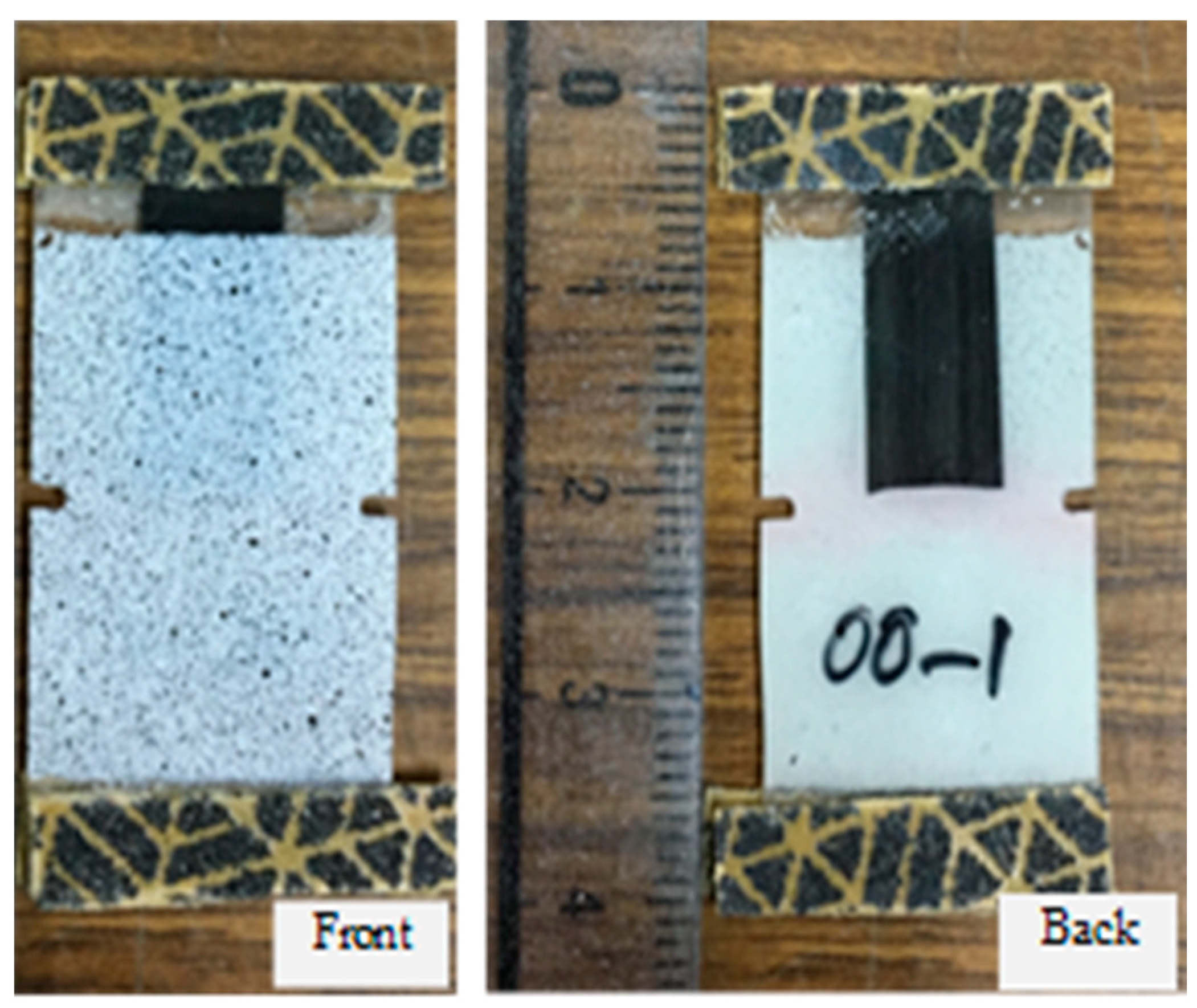
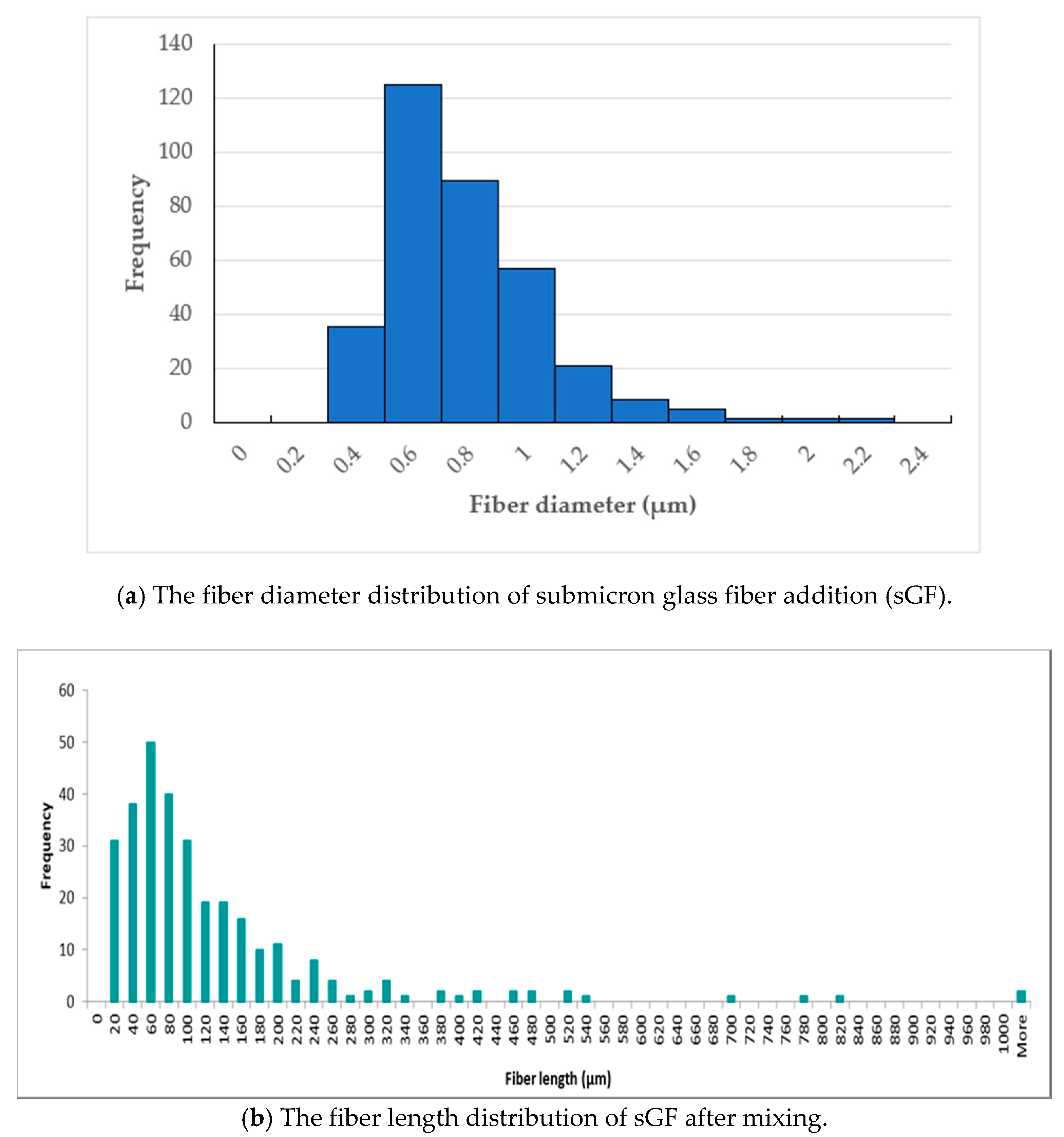
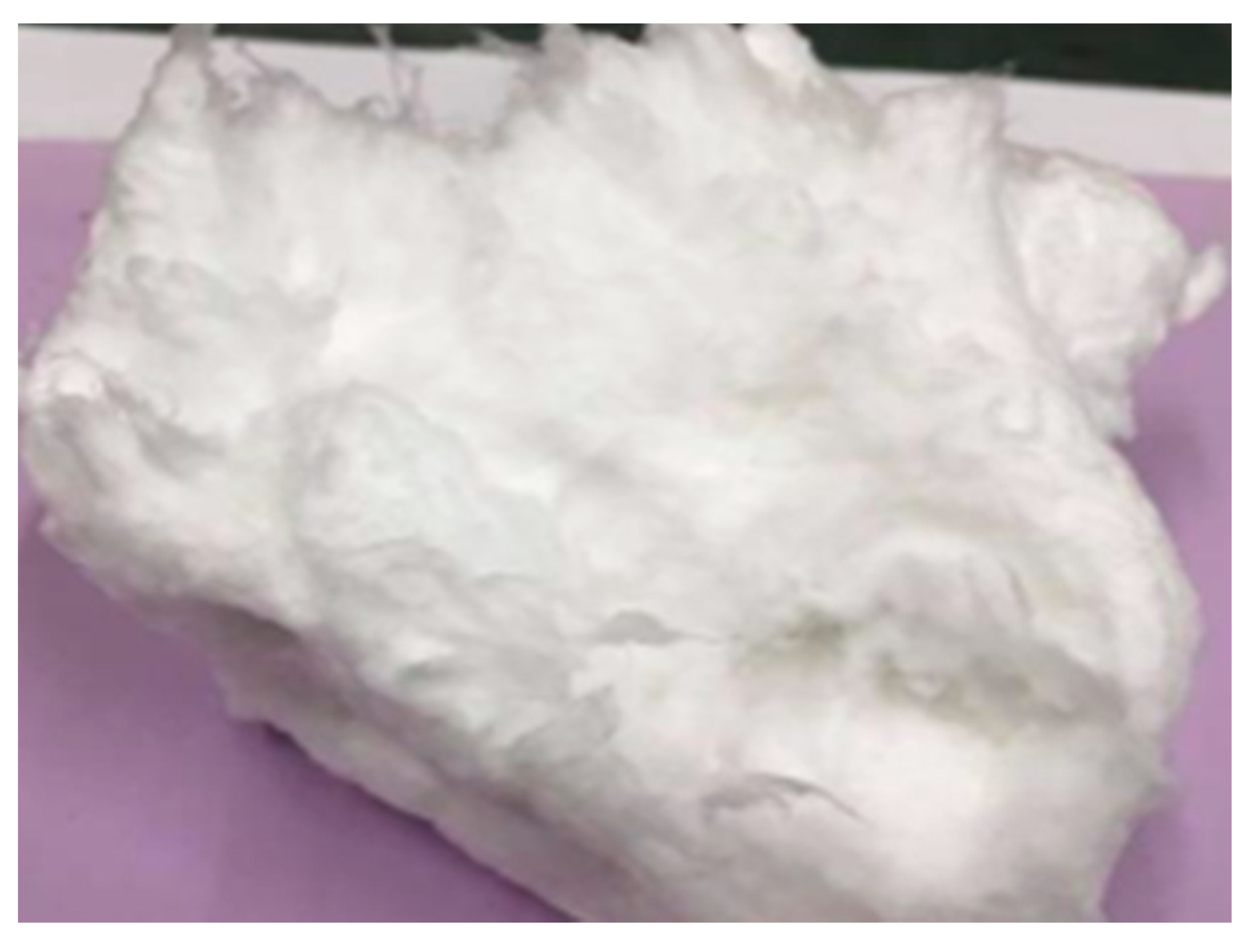
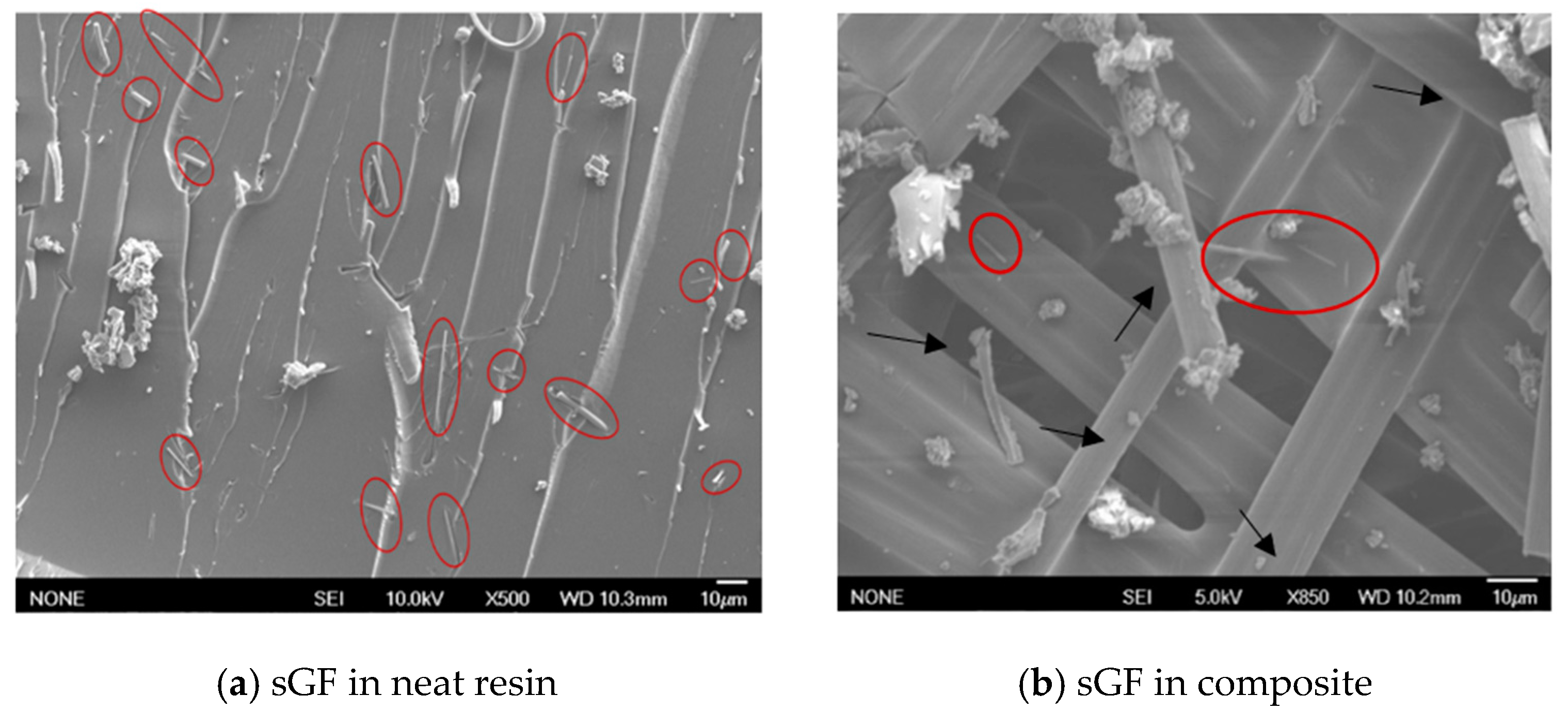


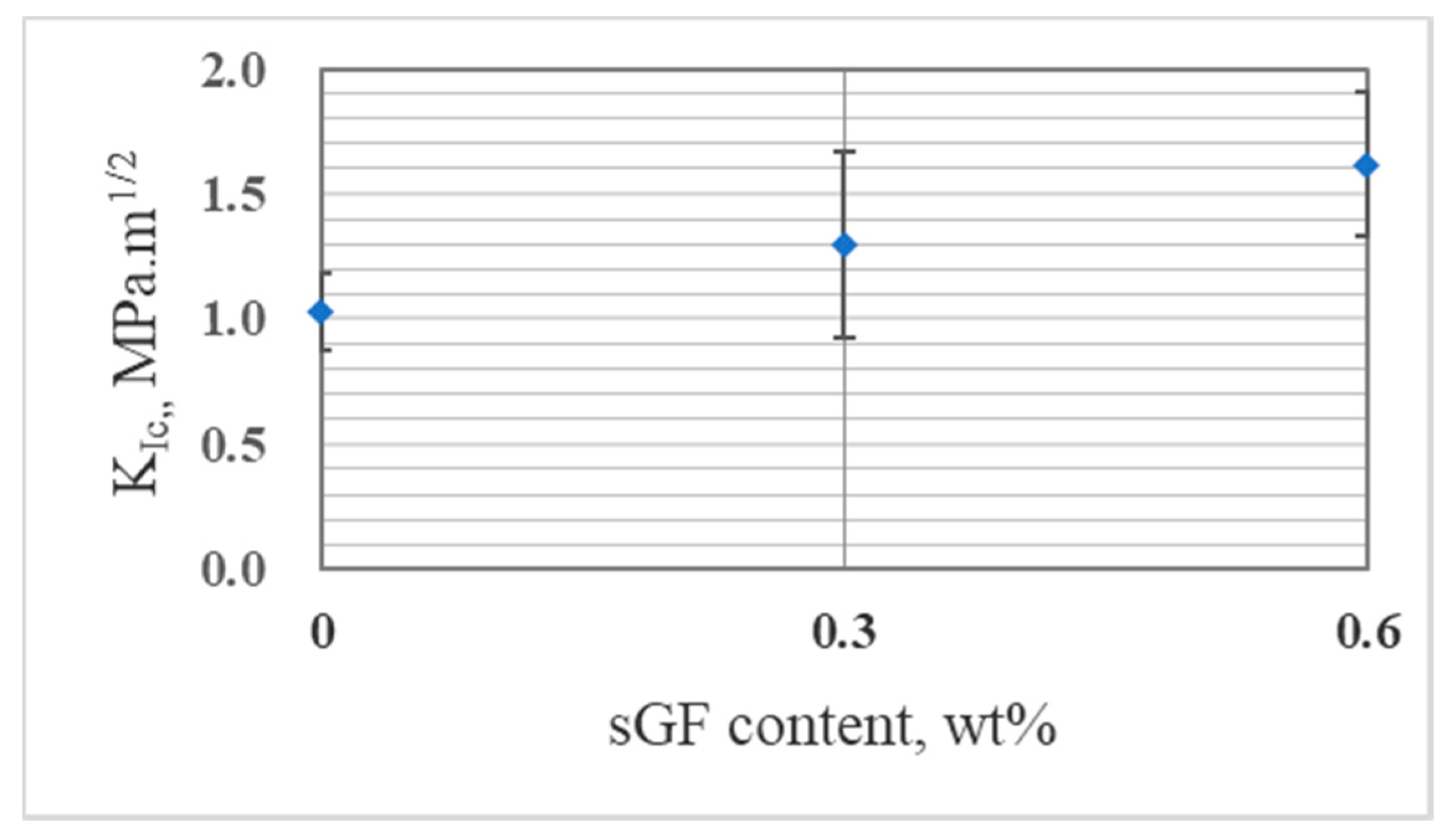
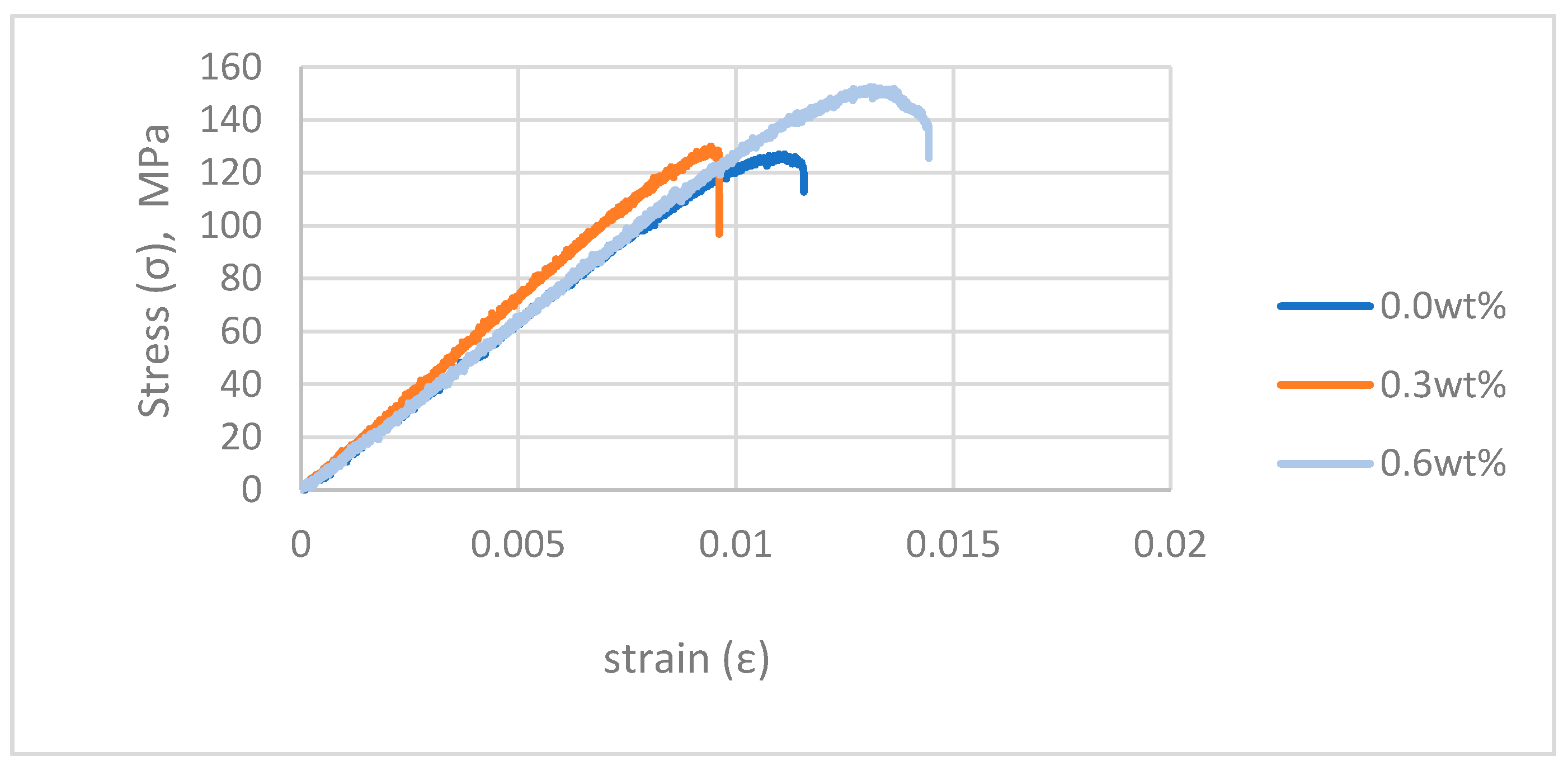
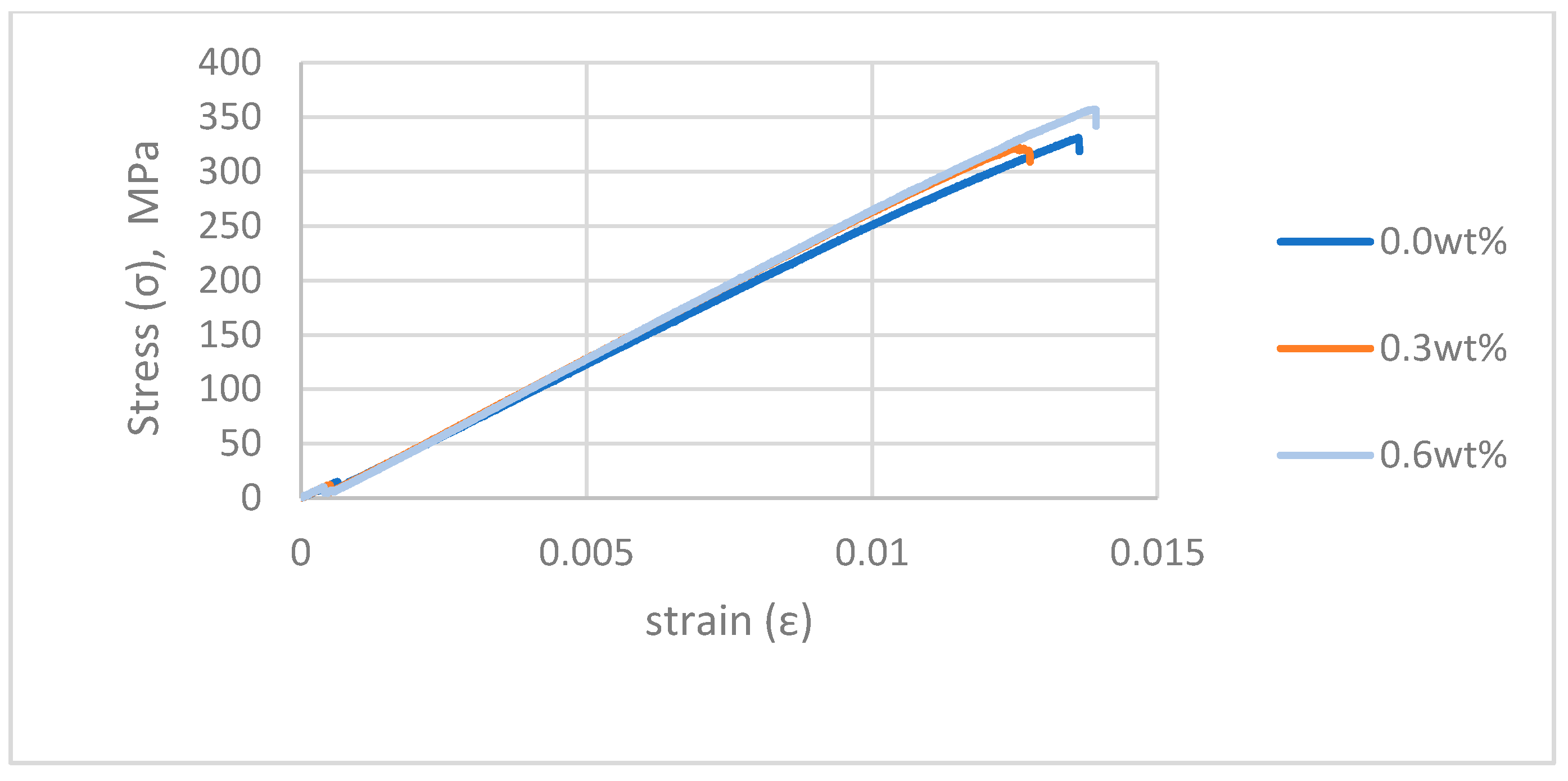
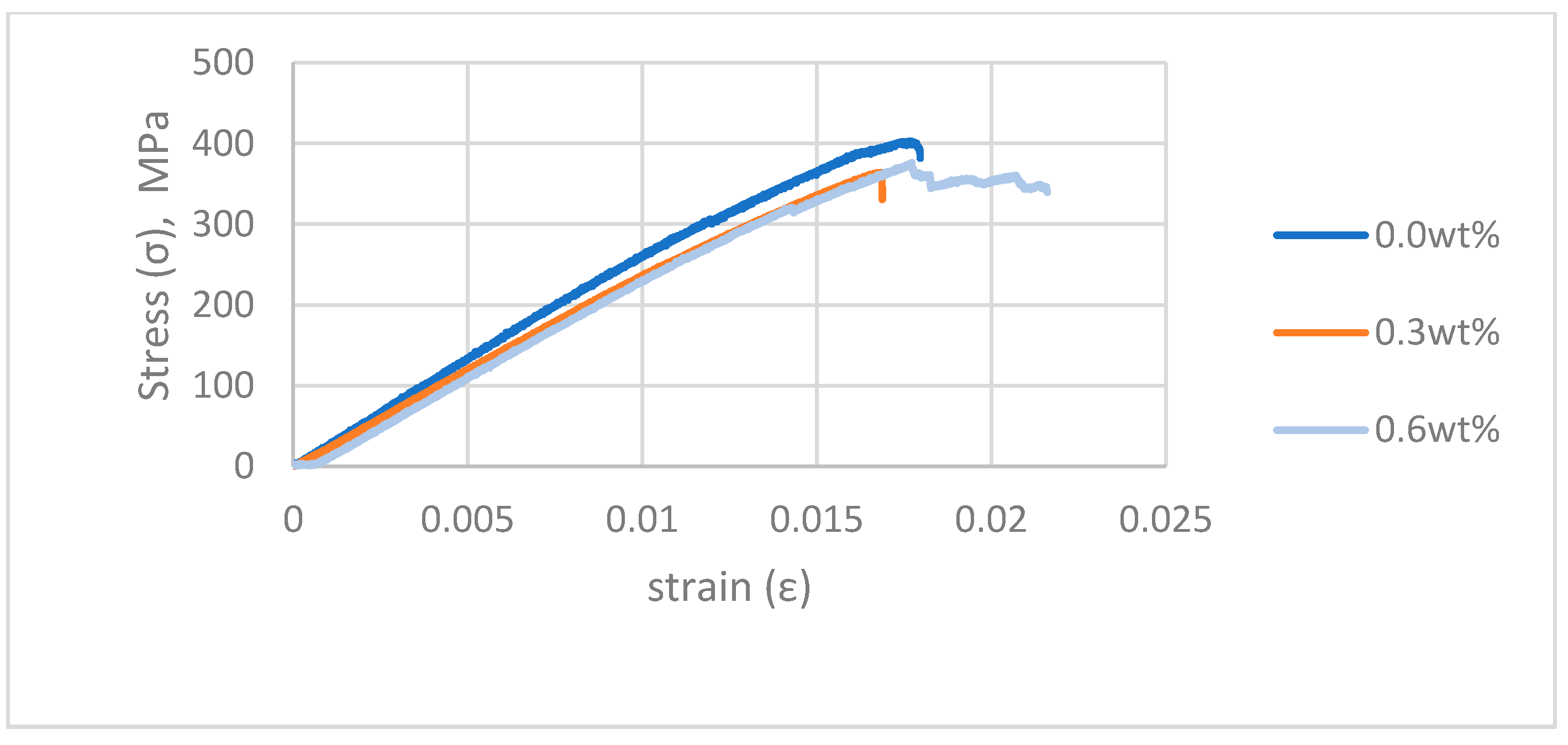
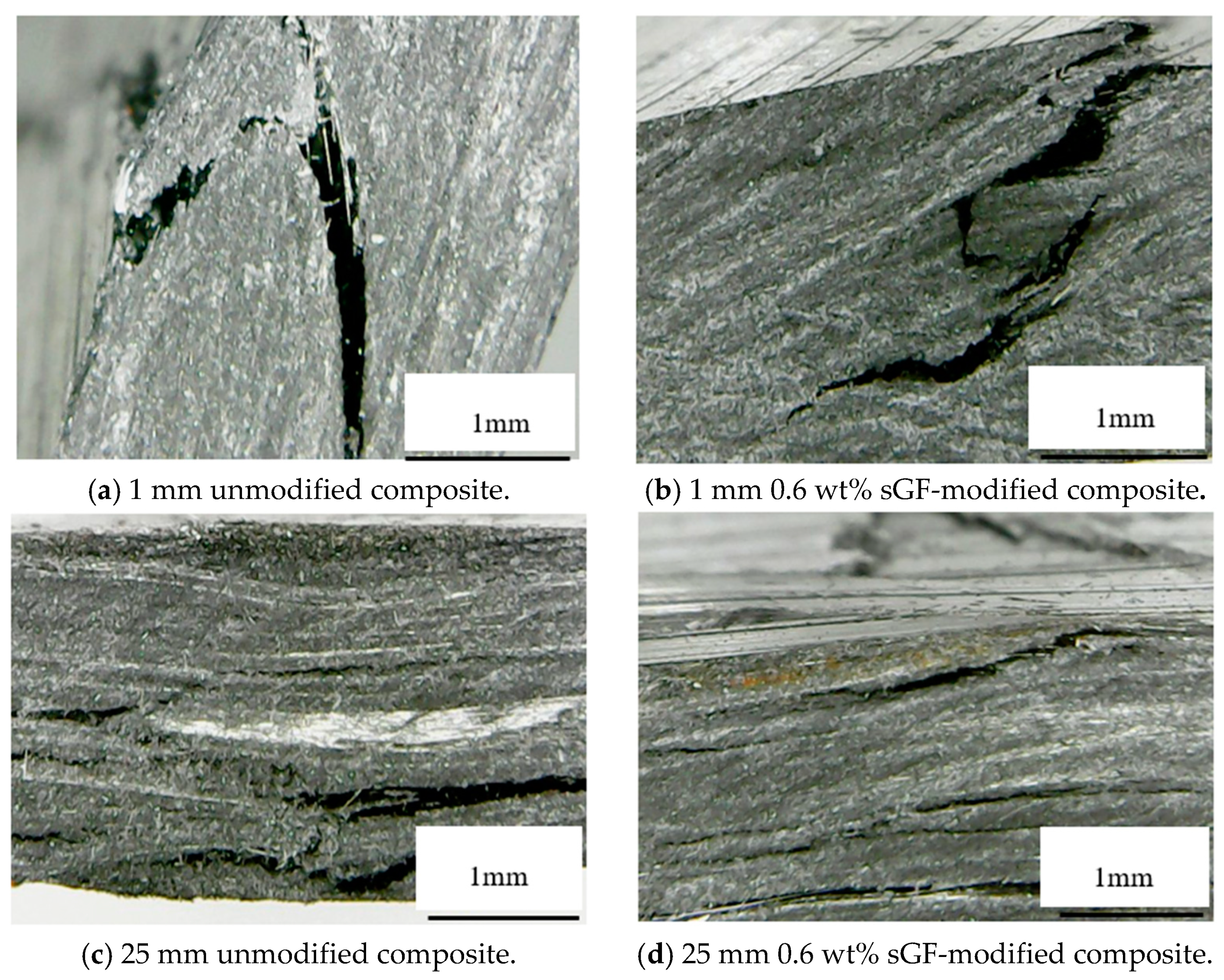

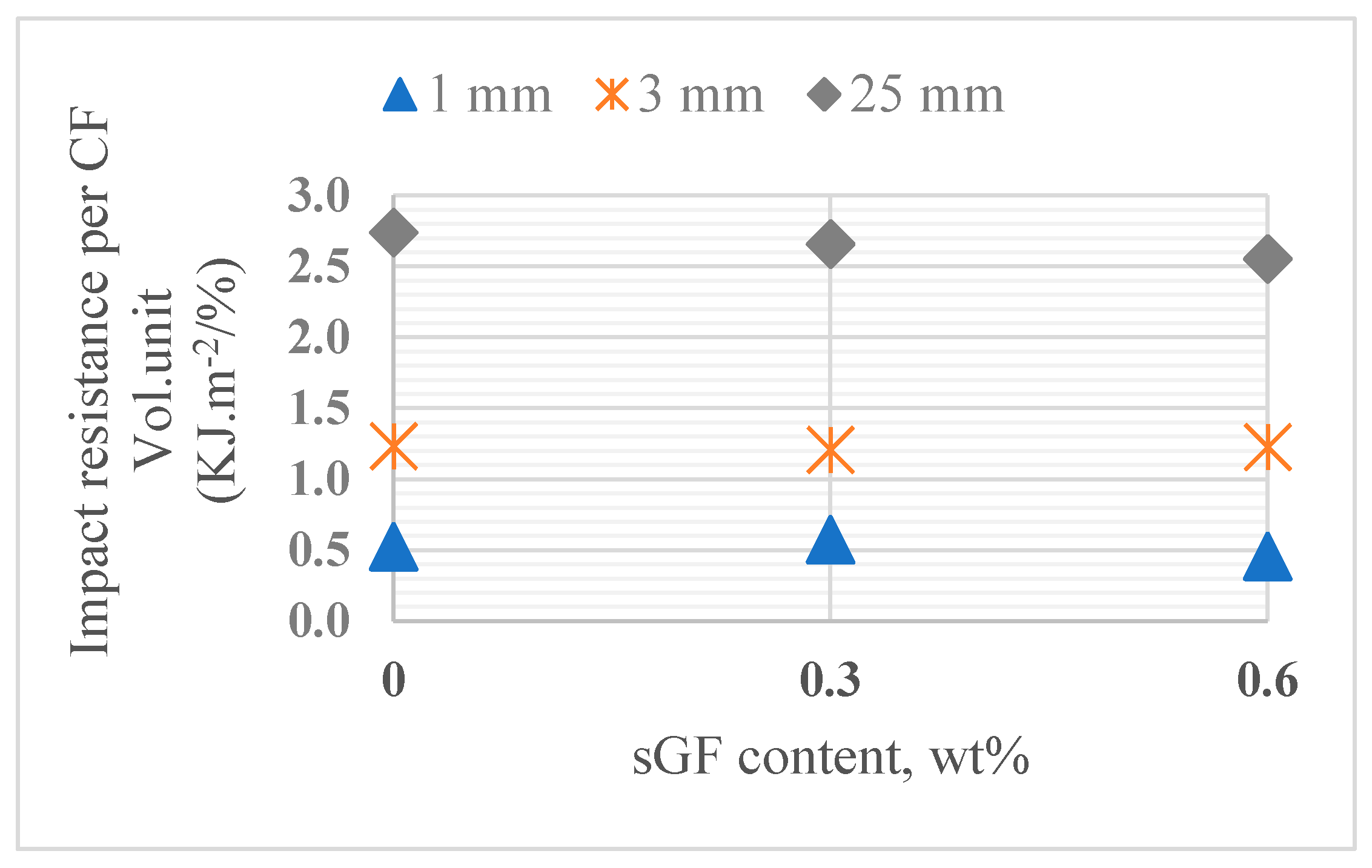
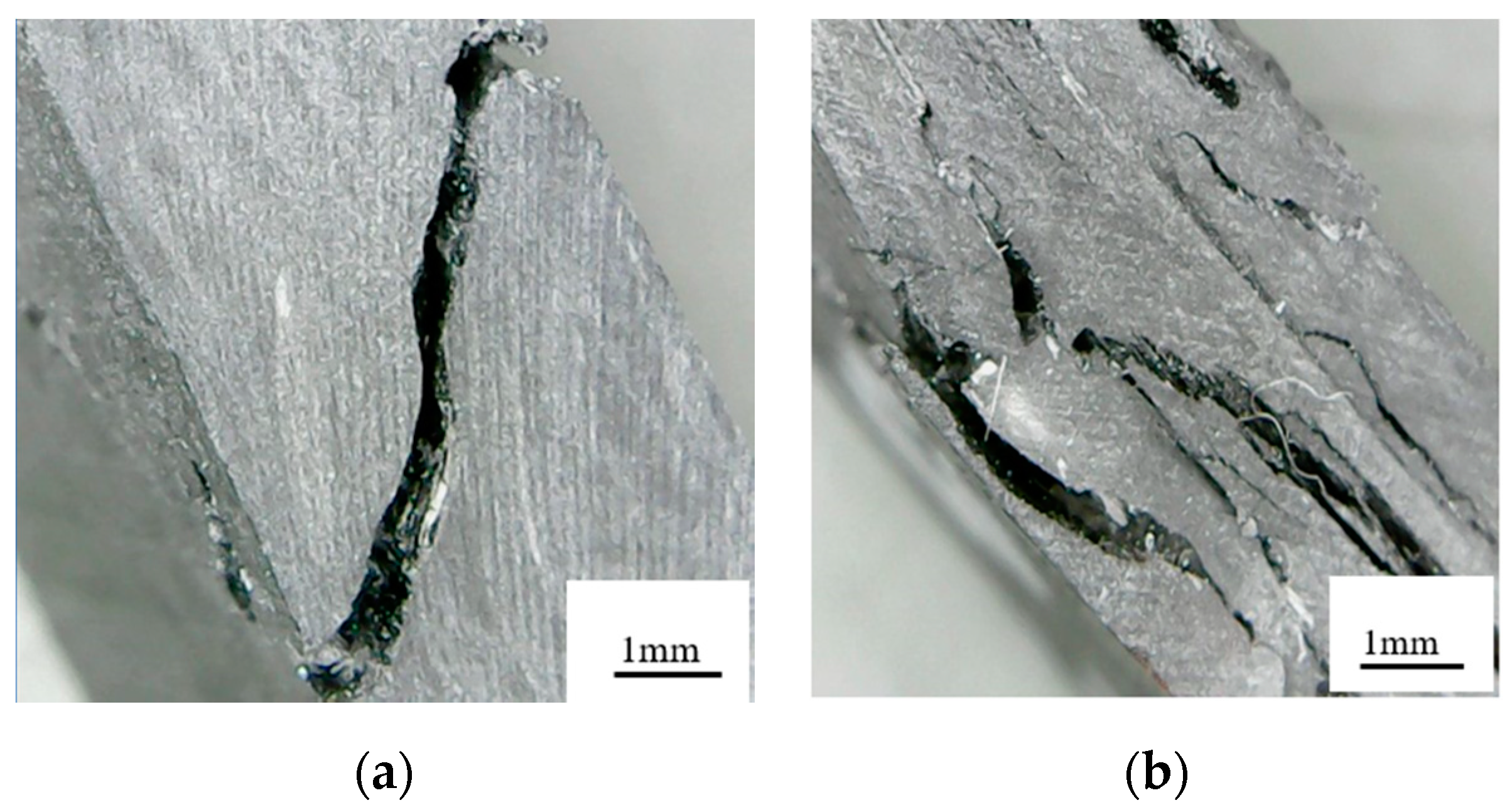
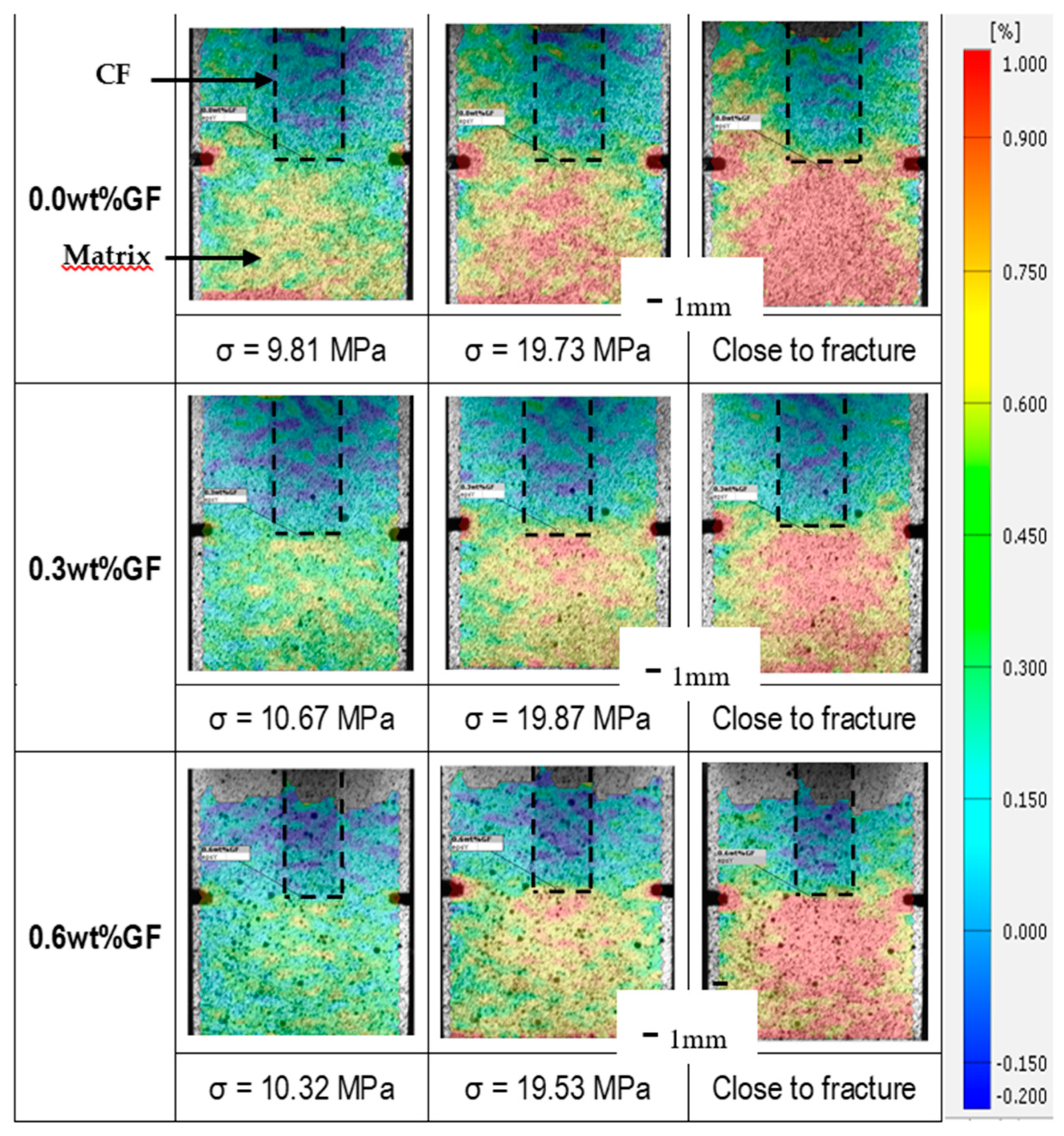
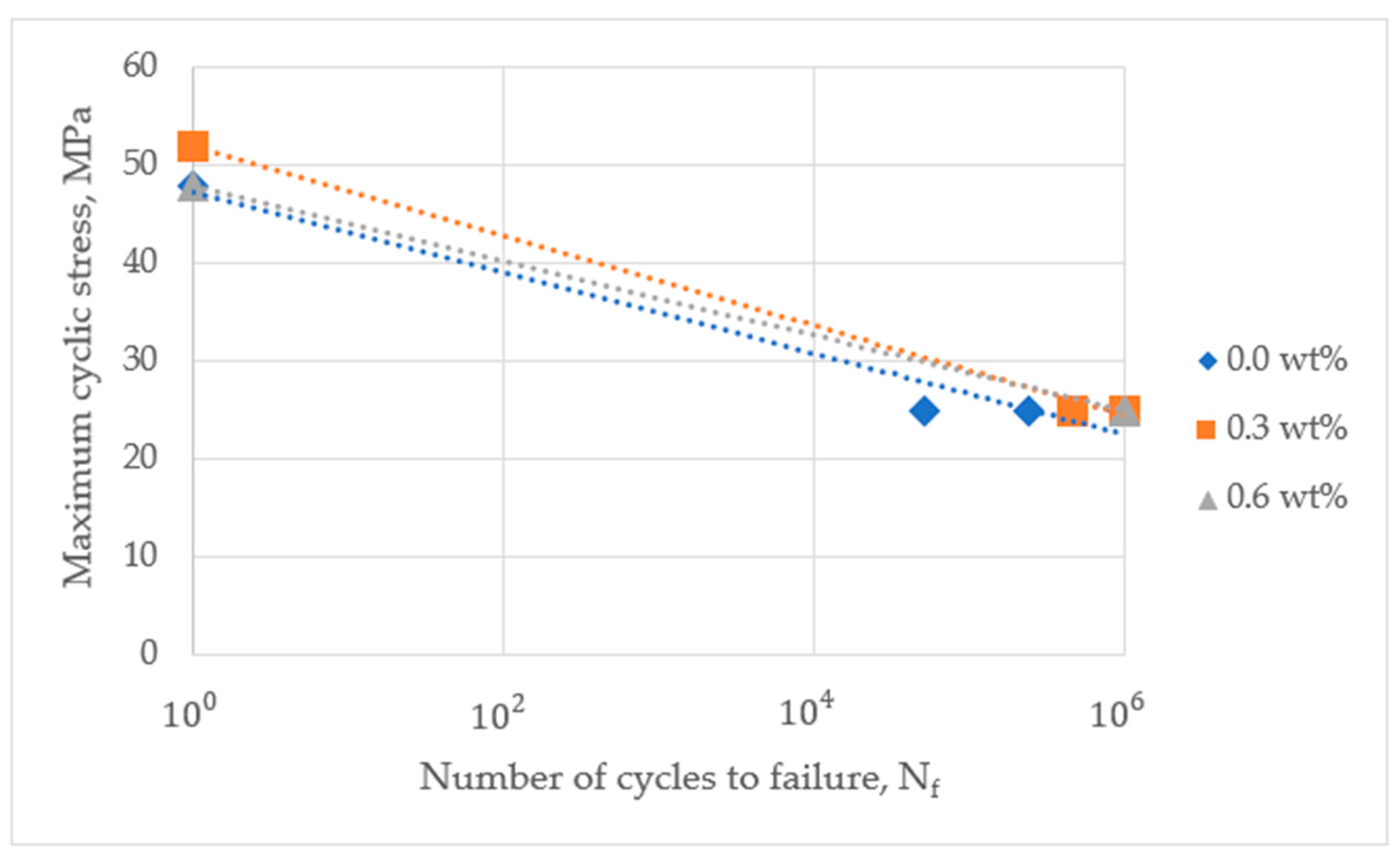
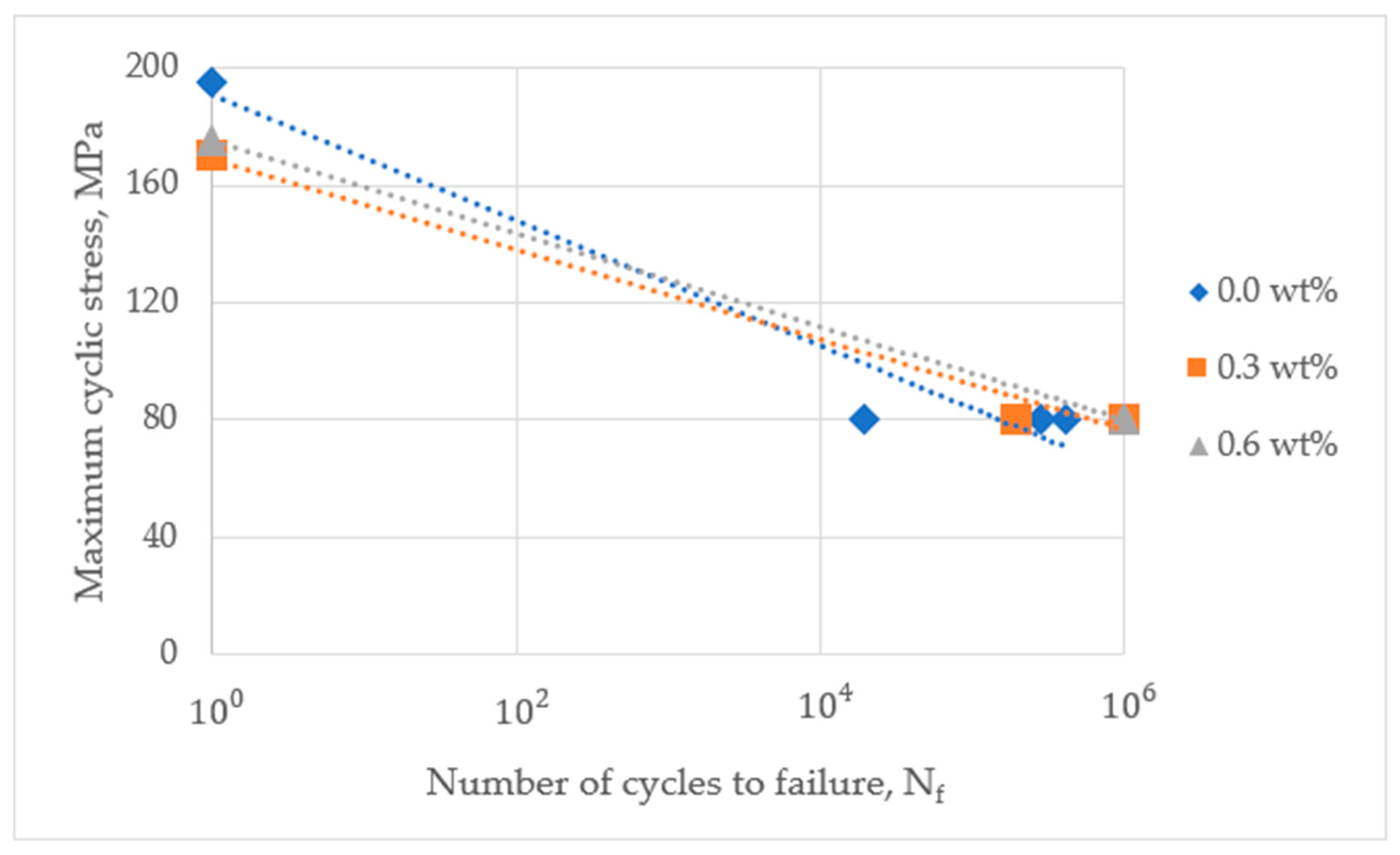
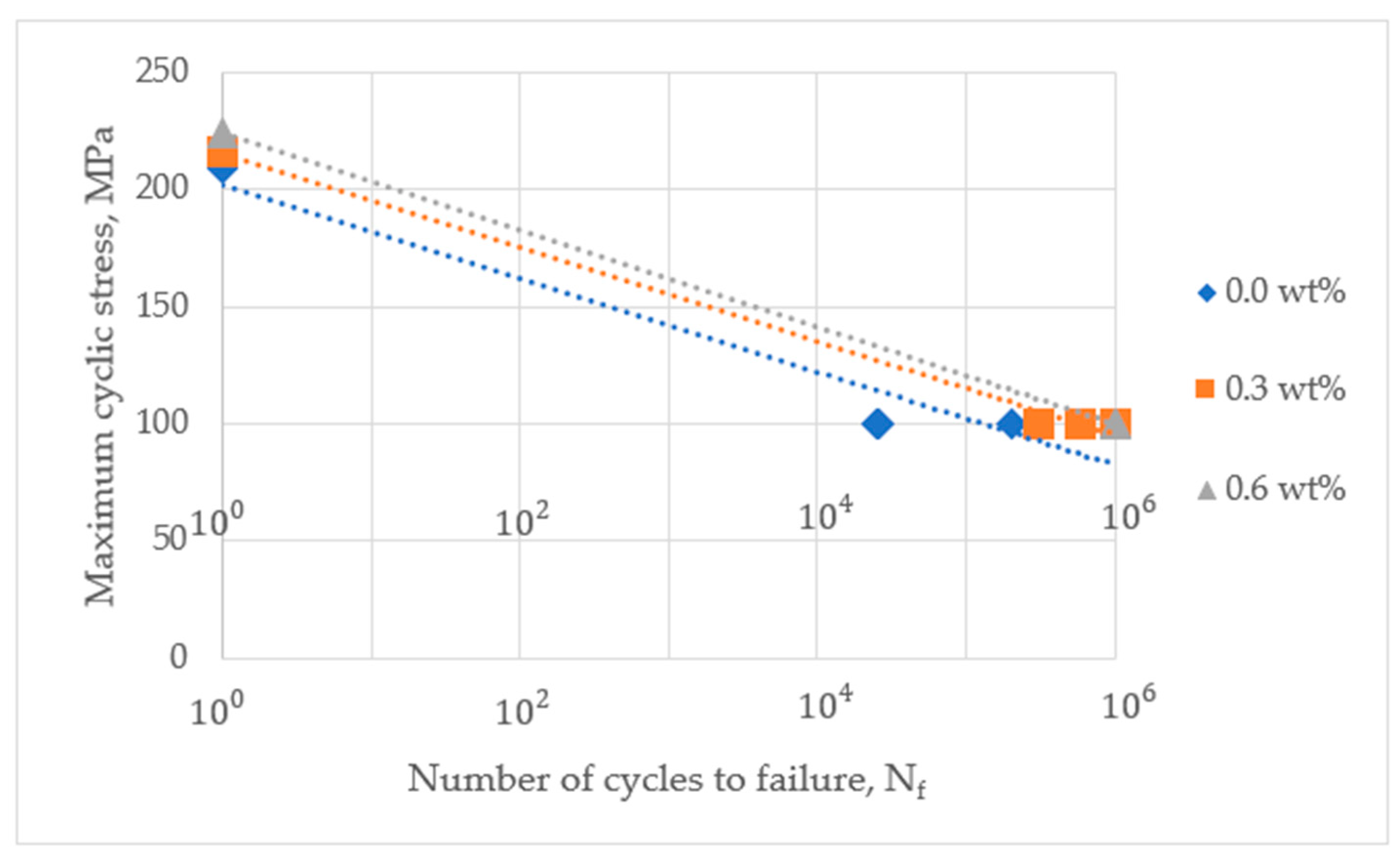
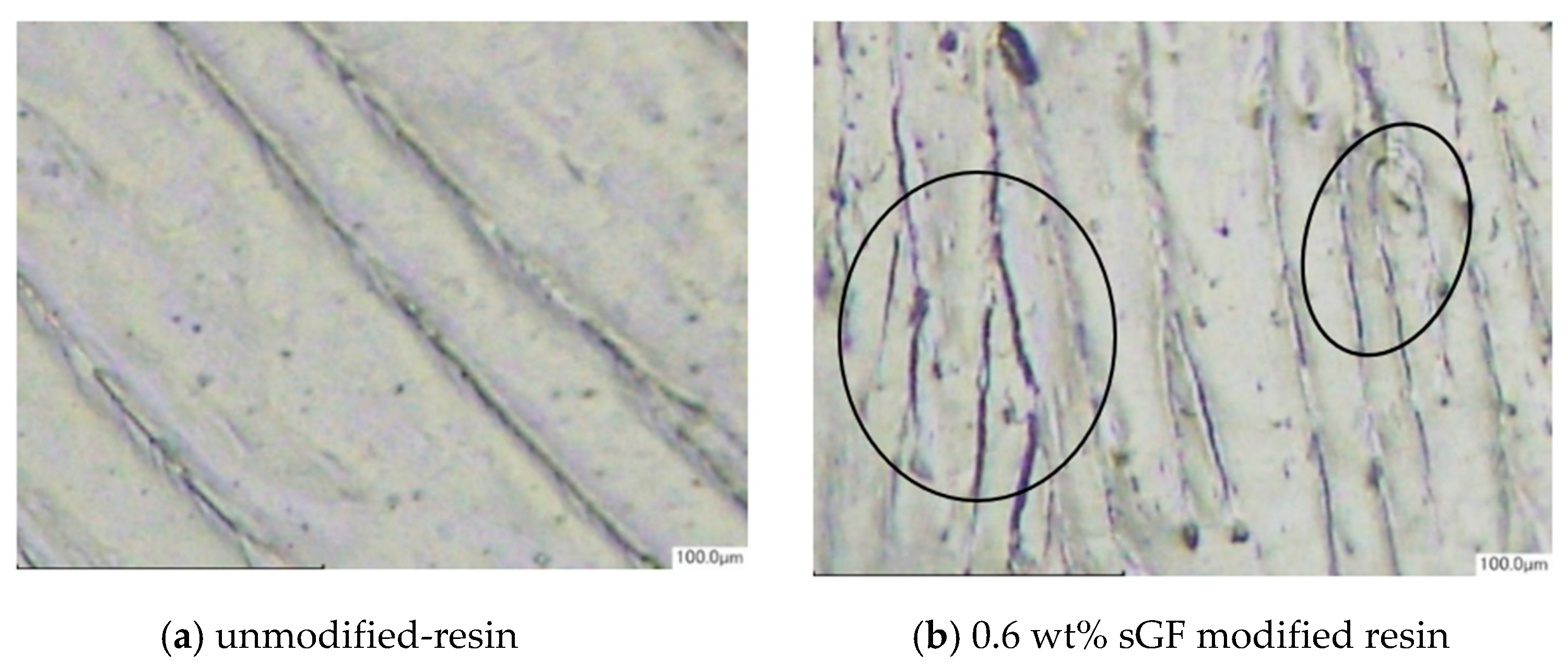
| IFSS (MPa) | |
|---|---|
| 0.0 wt% | 20.076 (3.4345) |
| 0.3 wt% | 20.93 (3.716) |
| 0.6 wt% | 20.17 (4.232) |
| Bending Strength, MPa | |||
|---|---|---|---|
| Composite | 1 mm | 3 mm | 25 mm |
| 0.0 wt% | 119.3 (8.76) | 329.1 (14.73) | 396.83 (57.5) |
| 0.3 wt% | 132.36 (18.3) | 317.27 (38.74) | 392.01 (75.83) |
| 0.6 wt% | 149.93 (16.03) | 336.91 (40.57) | 391.35 (90.53) |
| Neat resin | 127.77 (1.18) |
| Tensile Strength, MPa | |||
|---|---|---|---|
| Composite | 1 mm | 3 mm | 25 mm |
| 0.0 wt% | 46.28 (2.5) | 196.96 (13.67) | 208.98 (35.29) |
| 0.3 wt% | 53.53 (4.83) | 168.59 (36.69) | 215.96 (22.46) |
| 0.6 wt% | 47.7 (4.76) | 173.66 (25.71) | 224.74 (27.31) |
| Neat resin | 80 * |
| Composite | Bending Strength/Fiber Volume (MPa/%) | Tensile Strength/Fiber Volume (MPa/%) |
|---|---|---|
| 1 mm | 4.772 | 1.852 |
| 2 mm | 8.603 | 2.922 |
| 3 mm | 9.403 | 5.627 |
| 25 mm | 9.92 | 5.224 |
| Impact Resistance (KJ/m2) | |||
|---|---|---|---|
| Composite | 1 mm | 3 mm | 25 mm |
| 0.0 wt% | 13.14 (1.68) | 43.14 (5.6) | 109.59 (11.58) |
| 0.3 wt% | 14.36 (6.38) | 42.26 (5.68) | 106.324 (8.85) |
| 0.6 wt% | 11.43 (4.07) | 42.92 (5.41) | 102.19 (9.62) |
| Neat resin | 28.25 (7.99) |
© 2020 by the authors. Licensee MDPI, Basel, Switzerland. This article is an open access article distributed under the terms and conditions of the Creative Commons Attribution (CC BY) license (http://creativecommons.org/licenses/by/4.0/).
Share and Cite
Nguyen, N.T.T.; Kiyotaka, O.; Kazuya, O.; Toru, F.; Ou, S.; Hidehiko, T.; Yukiko, F. Effect of Submicron Glass Fiber Modification on Mechanical Properties of Short Carbon Fiber Reinforced Polymer Composite with Different Fiber Length. J. Compos. Sci. 2020, 4, 5. https://doi.org/10.3390/jcs4010005
Nguyen NTT, Kiyotaka O, Kazuya O, Toru F, Ou S, Hidehiko T, Yukiko F. Effect of Submicron Glass Fiber Modification on Mechanical Properties of Short Carbon Fiber Reinforced Polymer Composite with Different Fiber Length. Journal of Composites Science. 2020; 4(1):5. https://doi.org/10.3390/jcs4010005
Chicago/Turabian StyleNguyen, Nhan Thi Thanh, Obunai Kiyotaka, Okubo Kazuya, Fujii Toru, Shibata Ou, Tomokuni Hidehiko, and Fujita Yukiko. 2020. "Effect of Submicron Glass Fiber Modification on Mechanical Properties of Short Carbon Fiber Reinforced Polymer Composite with Different Fiber Length" Journal of Composites Science 4, no. 1: 5. https://doi.org/10.3390/jcs4010005
APA StyleNguyen, N. T. T., Kiyotaka, O., Kazuya, O., Toru, F., Ou, S., Hidehiko, T., & Yukiko, F. (2020). Effect of Submicron Glass Fiber Modification on Mechanical Properties of Short Carbon Fiber Reinforced Polymer Composite with Different Fiber Length. Journal of Composites Science, 4(1), 5. https://doi.org/10.3390/jcs4010005




